The crow descended as a black rain cloud
He disguised himself as Cupid, dressed in white jester wings
His black beak, a protagonist’s arrow
The seed of tragic love was planted
He grinned mischievously
Venus, believing she was unseen
Continued to inhabit other bodies, in other times, in other spaces
Between the shadows the crow struck her
A dagger blow delivered in a caress of a package
He slept, chuckling
Love soaked her as two realms collapsed
The mortal Adonis appeared, flawed
She embraced him, grasping at the intangible
Two young lovers forever about to kiss
Crow danced between them
Her grasp held a warning, silently playing
The prelude to the grand sorrow of love
As autumn leaves danced to a tune of melancholy
Through line time would have to pass
He fluttered his wings
The mortal urge is stronger than lust or love
He exited stage right, moving towards death
In his urge to hunt the boar dealt him that blow
A bleeding groin pulling him to death
Crow received a text
Laying in a pool of blood the crow arrived
Disguised as a river
He dragged Adonis’ empty corpse into limbo
Then drowned him in the river Lethe
The crow became the river
Adonis lay motionless, floating in the ether
In his Amnesia he remembered the pose of Venus
He became her unfading shadow
Grasping towards the past
The crow flew off, smirking
Notes for self:
Convergence of various plots: still to reliant on sources, to the point of pastiche. I have written some notes on these sources below to try help me realise the flaws in the process/approach/method.
River Lethe- one of seven rivers which flow to hell. Those who drink its water have a bout of amnesia, forgetting all that went before. Keats talks about it in Ode to a nightingale.
Hugely reliant on Ted Hughe’s the crow (continuing the idea of the crow as this anti God, a creature which with every move can condemn actions upon all humanity. I like the idea of an epic protagonist, capable of passing through all. I particularly like the idea, which I don’t think I have borrowed, of the Crow disguised as Cupid. There seems to be something particularly Shakespearian about that. Within love the seeds of tragedy grow. Which does not mean I am aligning myself with old Will, merely keen to pursue the kind of tragedy which is sown at the start of King Lear. I love the idea of the inevitability of the decent)

Titians Venus and Adonis Ovid’s Venus and Adonis. In each of Titians versions of this work the basic format is the same. The manner in which he moves from the Ovidian source is inspired….
In Ovid- Metamorphoses story unfolds in time through word and line.
In the painting: the prelude to the grand sorrow of the goddess of love
No singular moment in the poem which seems to condense the tragic drama into a pictorial solution. Rather than retell the narrative over a horizontal or recessive plan of reading Titian events a device which can condense the causal relation of events into one moment which can be seen rather than read. He seeks to find a pictorial solution to the poetic problem.
Titian invents the central exchange between Venus and Adonis, in which we can see her love for Adonis, through gaze and grasp and her fear of what is inevitable. Titian has translated a verbal warning into a visual depiction of physical restraint, which conveys the love of now and the fear of the future.
Adonis’ action: expresses the moment his natural instincts pulls him away from her literal grasp. Bold step forward and lean of the body give a powerful sense of movement and makes the break from her arms seem inevitable. His spear draws draws a line between, symbolic of the permanent divide which will be caused by his lust for such weapons ahead of her.
Dogs hungrily avert their attention to the next scene. Titian has translated a rebuttal of a request into a dramatic and pictorial rejection of a passionate embrace. The translation from word to picture has lead Titian to invent a pictorial equivalent to Adonis’ actions. This is what poesie is, the poetical evocation of a drama formed by exclusively pictorial devices. Painting as poetry on its own terms.
Props which point towards cause and effect of central action, the
supporting cast. Cupid- asleep, job down, set the story in motion, also suggests that love is now unable to intervene in the tragic unfolding of events.
Burst of light on right- suggests the return of Venus. Floating above a dark forest we can speculate she is looking down to the now dead Adonis. The forest certainly seems to resonate with such tragic potential.
Past and future events not shown but suggested. These do not precede or follow the central action but enrich and inform it. We do not move from one to the other but we stay engaged in the singular moment and pose.
Causal interrelation of parts in tragic plot have been condensed into one pictorial moment. Painting competing with poetry on its own grounds.
What most interests me about this is her pose. How Titian has found a visual, figural, motionless dramatic equivalent to the narrative causal plot. What I liked the idea of was taking her action, which seems to contain the seed of the tragedy, and posting it into the end seen, the death (or post death) of Adonis. The notion that once dead, when floating in Lethe, his figure resembles her pose. As if the two moment have collapsed. As if the tragic potential of her grasp is fully realised in his floating dead corpse, which appears to grasp at empty space behind him, as if reaching for what was (off stage to the left ie the past). A kind of visual symmetry in the love and death. A kind of parallel opposite of joy and despair that Keats speaks about in Ode to Melancholy.
Other visual notes about the work-
Wanted to create a dynamic where two diagonals cross each other. Defiantly need to pursue this kind of visual mathematics. I think it is where my mind natural moves towards. The use of space for dramatic effect.


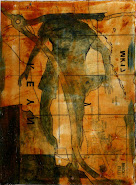

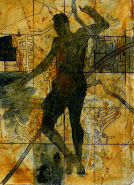

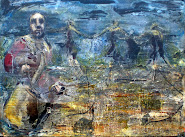

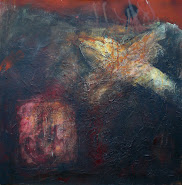

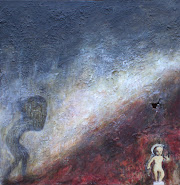

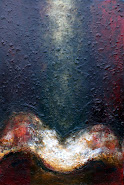

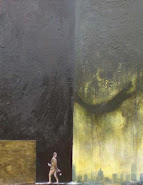



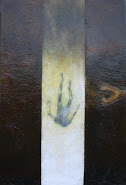





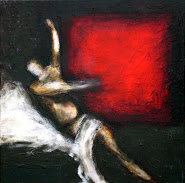


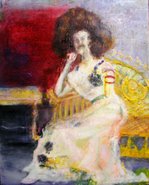
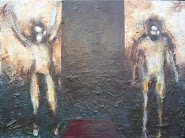


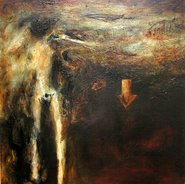
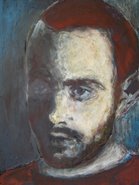
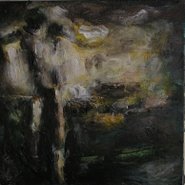
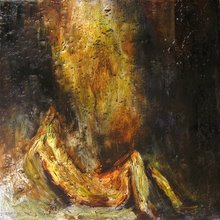
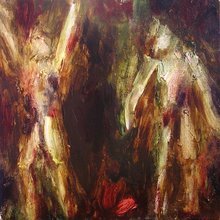
No comments:
Post a Comment